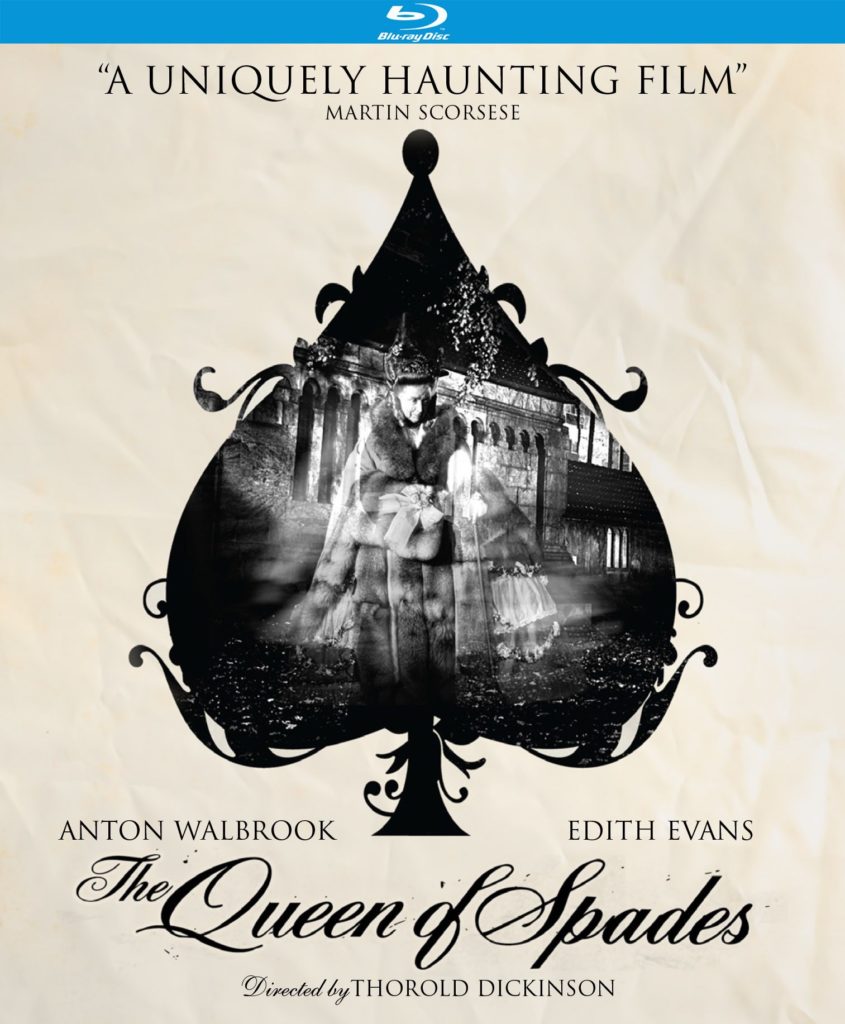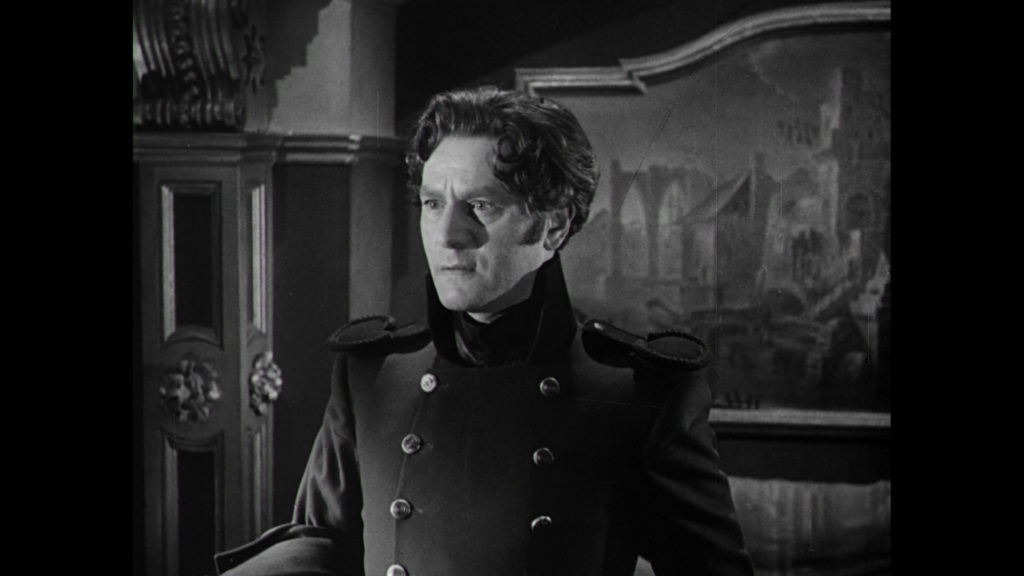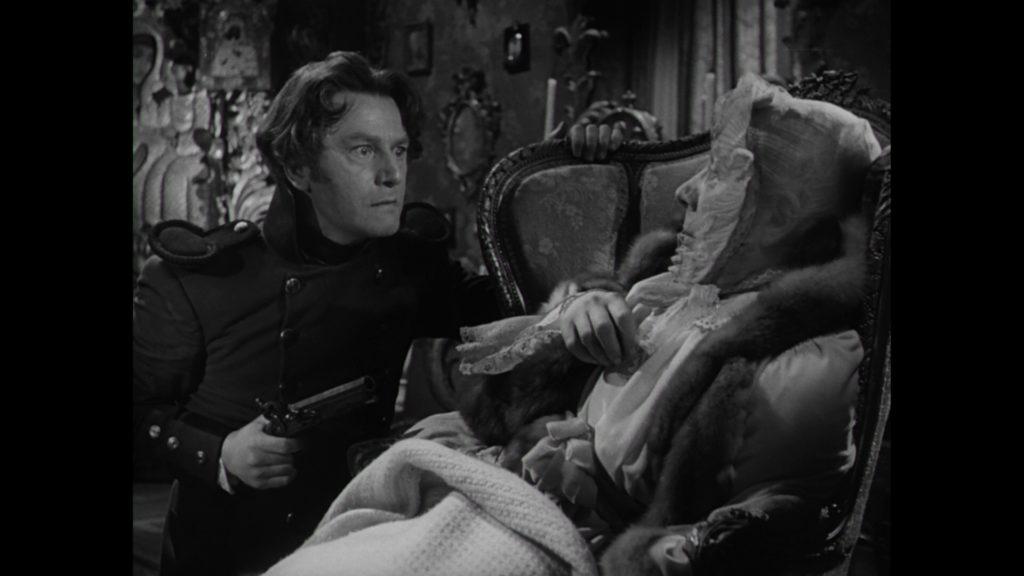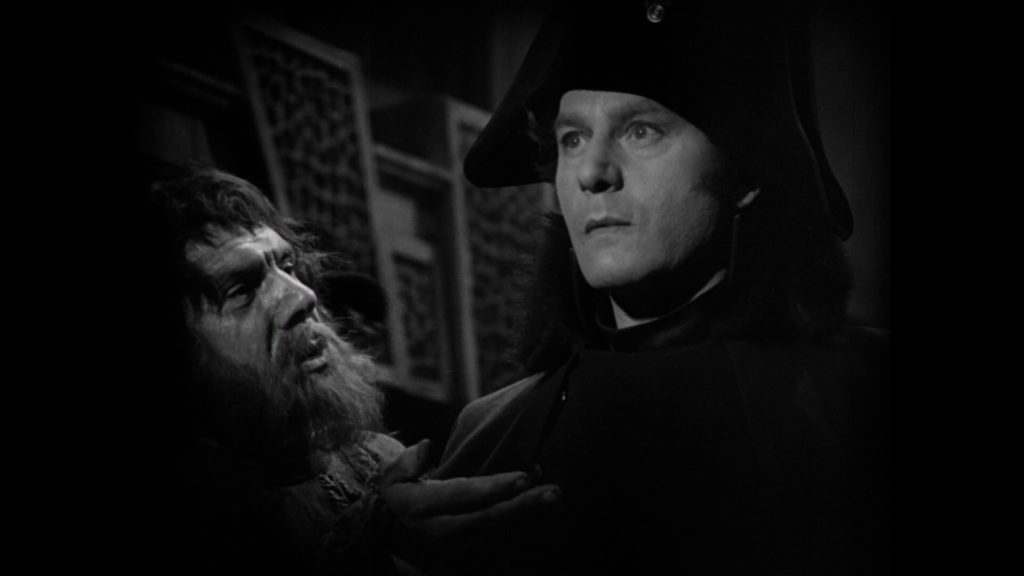Would-be Conqueror In Tsarist Russia Turns Up Losing Card
DIRECTED BY THOROLD DICKINSON/1949
STREET DATE: OCTOBER 15TH, 2019/KINO LORBER STUDIO CLASSICS

Shot entirely on cramped sound stages in postwar Britain, Thorold Dickinson’s The Queen of Spades almost inexplicably recreates the artistic shadow of early nineteenth century Russia in all its terror and glory. Austrian actor Anton Walbrook, Czech cameraman Otto Heller, French composer Georges Auric, Russian producer (and uncredited co-writer) Anatole de Grunwald, working on sets extravagantly designed by Walbrook’s fellow countryman William Kellner, collaborate to raise the spirit of a dead world with the dread intensity of prewar European cinema. Eschewing the “stiff upper lip” style of his national contemporaries, British director Dickinson (1940’s original Gaslight; also starring actor Walbrook) casts a very different spell on lush yet chiaroscuro-soaked mise en scene that brilliantly matches the tortured yet relentlessly self-driven mental state of its anti-hero protagonist.

Opening on a (historically accurate) gambling craze sweeping 1806 St. Petersburg, the exotic faro dens presided over by gypsy singers and dancers (Maroussia Dimitrevitch, Violette Elvin) are haunted by a lowly captain in the Engineers division of the Tsar’s army named Herman Suvorin (Walbrook). Considering himself too impoverished to participate in these games of reckless chance and feverish play, Suvorin, overhearing stories related to the Curse of the Queen of Spades, looks hungrily over the hunched shoulders of his aristocratic betters and imagines himself in their place; particularly in the oft-occupied seat of his friend, the wealthy and well-connected Andrei (Ronald Howard). Nursing financial and militaristic ambitions on a scale equal to the meteoric rise of his similarly lowborn hero Napoleon, international scourge of European power and privilege, a casual visit to a musty bookseller’s shop, where an accidental unshelving of his military idol’s campaigns lurches forth a volume of a decidedly different character to the dust-covered floor below, seems to answer his own fixation on attaining wealth and power.
Containing a lengthy account of one “Countess R.”, who in the hair-pilloried and hoop-skirted days of the mid-eighteenth century sold her soul to a mysterious foreign dignitary in exchange for gambling riches, Suvorin connects the legend with the near-century-old Countess Ravenskaya (Edith Evans), the wealthiest woman in St. Petersburg who is rumored to have attained her fortune from supernatural knowledge of “the secret of the cards”. Soon ingratiating himself with the countess’s young ward Lizavetta Ivanova (Yvonne Mitchell) as a means to gain entrance to the house, Suvorin one evening secretes himself in the ancient countess’s private chambers for a similar exchange to that of eighty years before; one that, past death and further encounters beyond the grave, will ultimately lead to the fated, dissolving faro table turn-up of the title card.

Based on Alexander Pushkin’s 1834 story, which evoked the dire uncertainty of a previous generation of Russian history in its tale of dark obsession, grim inheritance, and thwarted ambition, the 1949 British filming of Queen of Spades, displanted by distances of two continents and one century, nevertheless spiritually (dis)embodies its moribund milieu, polyphonic vocalizations ringing spectrally throughout an Expressionist Orthodox cathedral, with the startling creepiness of an open-casket, postmortem transaction between a live soul and a dead one. These exchanges between the barely-living and the near-dead include a both silent (on her part) and shrieking (on his), pistol-bearing interview in the countess’s chambers; the aforementioned, funeral-set encounter between a live corpse and a dead one; and finally the visitation of the roaring midnight voice, fire-breathing the cards’ winning secrets through Suvorin’s darkened chambers like a hurricane inferno. As one of the more effective evocations of the supernatural on film, the uncanny nature of Suvorin and Countess Ravenskaya’s trio of morbid interactions depicted in the film are most astonishing for their dramatic, psychological, and indeed metaphysical ambiguity.
Preserving the restricted point of view of Pushkin’s original story, in which Suvorin the narrator almost seems to ill-fatedly will the narrative towards the turning of the winning “ace” at the story’s conclusion, Walbrook as the cursed captain, like the actor himself, a displaced ethnic German living for political reasons in a foreign state, dominates every story-twist and -turn with the narratively- and thematically-appropriate, Napoleonic will of a would-be conqueror. A performance whose like had not been seen, perhaps, since the day of silent films, the review’s introductory mention of Queen of Spades’ Russian producer, Czech cameraman, French composer, and Austrian production designer similarly imparts the entire production with an expressive character wildly out of keeping with, say, the low-key icy breeze of the noble Polar sacrifice (1948’s veddy veddy British production of Scott of the Antarctic, by name) whose reversed and amplified soundtrack provided a fair sonic portion to the previous paragraph’s described death roar.

Shot on a mere week’s notice by director Thorold Dickinson, replacing original director (and credited co-writer) Rodney Ackland just before shooting on the suspended production was to have commenced, Queen of Spades betrays little evidence of artistic uncertainty, the vivid directorial touches of rag-swaddled mendicants clawing the elegant elite as they step out of lavish carriages; the halting swish of a centenary’s heavy dress announcing both a life little left to be lived and a terrifying existence beyond; the soundtrack’s climactic insistence on the diegetic and non-diegetic repetition of the “winning” card sequence (“Three, Seven, Ace!”) create an entire world out of less than a month’s worth of shooting, a severely limited budget, and the austere working conditions of postwar Britain. Despite or perhaps even through the production’s considerable (external) limitations, Queen of Spades makes one feel the (internal) force of an unfamiliar time and place, presupposing no knowledge of Russian history, towards the oppressive hammer-thud of an Ace unaccountably transforming into the Queen of Spades. For a moment, one may even become Captain Herman Suvorin of the Tsar’s Engineers brokenly muttering “Three, Seven…?” across sixty subsequent years of diminishing international cinema.
As may be attested to, perhaps, by this rather breathless review. If one’s interest has been nevertheless piqued by the reviewer’s poor performance, however, Kino Lorber’s deluxe Blu-ray, admirably preserving a pellucid visual presentation receiving much attention and acclaim at worldwide festivals and revivals the past decade, comes with many special features to recommend it further, including an as always passionate filmed introduction from Martin Scorsese, an incisive video-recorded analysis from critic and author Philip Horne, two lengthy audio clips from 1951 and 1968 featuring director Thorold Dickinson, and finally a feature-length commentary from film critic Nick Pinkerton. The last is certainly the most informative on the complicated genesis of the film, its unusual production, and most of all Queen of Spades’ unique quality and lingering effect; the latter even seeming to raise the emotional temperature of the commentator’s accustomed monotone to an at times almost Walbrookian level.
A key work of British cinema, almost apart from its traditions, yet entirely a part of its consistent level of quality, Queen of Spades will, one hopes, continue to cast its (haunting) spell over receptive vewers for many (haunted) generations to come.
Images used in this review are credited to DVDBeaver. Thanks to Kino Lorber for providing a Blu-ray copy.

